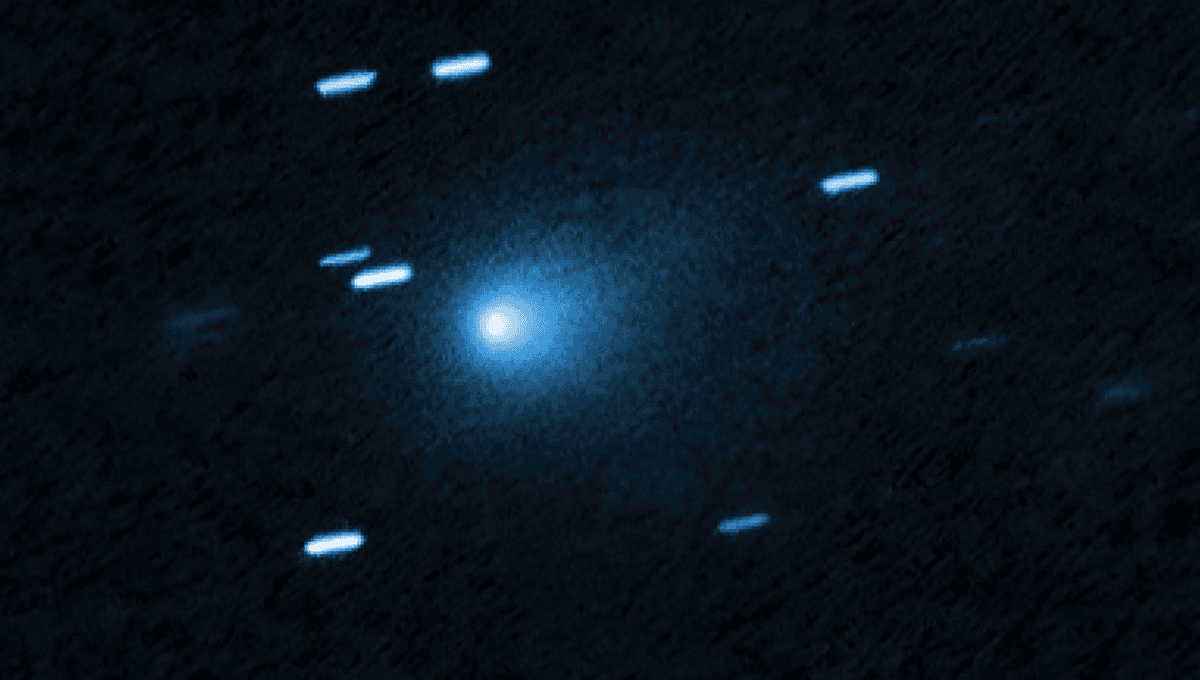
Fast-moving objects like interstellar comet 3I/ATLAS may be planet-forming seeds, potentially helping to solve an old Solar System mystery.
On July 1, 2025, astronomers spotted an object moving through the Solar System at nearly twice the velocity of previous interstellar visitors ‘Oumuamua and Comet Borisov. The object, which was confirmed to be an interstellar comet with its own dusty coma, is far larger than the previous two, with an estimated nucleus (the rocky part of the comet, excluding its coma) of around 5.6 kilometers (3.5 miles).
Early work showed that it is of huge interest to scientists, beyond being the third confirmed interstellar visitor. For a start, it may have come from a different region of our galaxy altogether, and may be far older than any of the known bodies in our Solar System.
The object, like ‘Oumuamua and Borisov before it, has attracted a lot of wild hypotheses, including the outlandish suggestion that it could be an alien spacecraft, earning a response from NASA.
While that idea is farfetched and unnecessary to explain what we have seen of the comet, there are a few interesting mysteries which observing these objects could help resolve. At the Joint Meeting of the Europlanet Science Congress and the American Astronomical Society’s Division for Planetary Science (EPSC-DPS2025), Professor Susanne Pfalzner of Forschungszentrum Jülich in Germany presented the idea that they could act as “planet seeds”.
Planets form in protoplanetary disks, vast rings of gas and dust which gradually accrete into massive bodies through collisions, either rocky planets or the cores of gas giants. But there are issues with this model, including massive planets astronomers have found which appear too young to have formed.
“Two potential problems with this scenario have been found: i) a relatively long formation timescale, especially for giant planets, and ii) growth barriers during the accretion process,” Pfalzner and co-author Michele Bannister explained in an older paper.
“The accretion model requires timescales of 102−104 yr to form millimeter to centimeter sized pebbles, 104 −106 yr until the planetesimal stage is reached, 106 −107 yr to form terrestrial-type planets, and an additional 105 yr for the gas giants to accumulate their gas. This seems at odds with observations of the disk frequency in young clusters, which indicate the median protoplanetary disk lifetime to be merely 1–3 Myr for both dust and gas.”
A particular problem is that models of planet formation struggle to explain how objects larger than around a meter (3 feet) form, as simulations suggest boulders bounce off each other or shatter when they collide, rather than coalescing into a larger object. According to Pfalzner and Bannister, interstellar objects could “function as seeds for fast and efficient planet formation”.
“Interstellar objects may be able to jump start planet formation, in particular around higher-mass stars,” Pfalzner said in a statement at EPSC-DPS2025. “Interstellar space would deliver ready-made seeds for the formation of the next generation of planets.”
High-mass stars would draw more interstellar objects towards them due to our old friend and foe gravity, where they could accelerate planet formation by providing a site of nucleation. In simple terms, if a small object smashed into it, these larger “seeds” would not break apart as easily, nor bounce off, and the result is faster planet formation.
“Higher-mass stars are more efficient in capturing interstellar objects in their discs,” Pfalzner added. “Therefore, interstellar object-seeded planet formation should be more efficient around these stars, providing a fast way to form giant planets. And, their fast formation is exactly what we have observed.”
“Interstellar space would deliver ready-made seeds for the formation of the next generation of planets.”
This idea, if correct, could also explain why gas giants like Jupiter and Saturn are rarer around smaller stars like M-dwarfs. Gas giants around Sun-like stars are also problematic, as the protoplanetary disks are expected to last around 2 million years before dissipating, not providing long enough timescales for gas giants to form. In this scenario, an interstellar seed would speed up the process significantly.
It’s an interesting idea, and one which will surely be tested as we get more information about these interstellar objects, and hopefully observe many more. If correct, it could mean that Earth (or other planets which formed later on in the universe) may be partly of interstellar origin.
“This seeding scenario also implies that planet formation was slower in the earliest generations of stars,” Pfalzner and Bannister concluded. “Planetary differentiation will surely disperse the original ISO [interstellar object] material, which is also <<0.1 percent of the mass of even a terrestrial planet; the bulk planetary compositions will be dominated by that of the disk. Yet ISOs from an ancient star may have once been the hearts of many young planets."
Further study of these objects and planetary formation is needed, but the team suggests we may need to include interstellar objects in our planetary formation models in the future.
The latest findings were presented at EPSC-DPS2025.
Source Link: Forget Alien Spacecrafts: Could Interstellar Object 3I/ATLAS Be A Planet-Forming Seed?